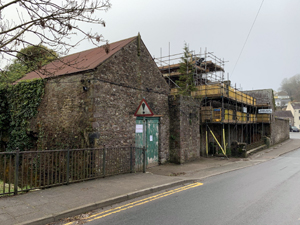
Island House
The exclamation mark on the sign is appropriate as Island House is a riddle and impossible to date: remains of a
Roman baths and round tower were found in the garden; the wall facing the road is partly medieval (and as thick as the castle) and
there were Tudor and Edwardian alterations. The house was named because the Mackerelle and Corran rivers flowed either side and the
sea regularly encircled it. Records state it stood between 'Earth Lake' and 'Mill Orange'.
The last wolf in the area was killed in Amroth in 1576 and rather creepily, the footpads were kept in Island House.

Edward Wienholt was born in Island House on 28 March 1833, the son of John Birkett Wienholt (1775-1852), a merchant,
and his second wife Sarah, née Hill.
Edward Wienholt arrived in Queensland in 1853 and Arnold, his brother arrived in 1857. Both Edward and Arnold became a member of the Queensland Legislative assembly.
Their elder sister Mary, was commemorated by the building of St Martin's Church lychgate by her sister Ellen.
Edward named his son Arnold (pic above) who went to Eton and became a celebrated war hero and published author in Australia.
Having made it through the first World War he died in an ambush in the second, aged 53.
His book was called, The Story of a Lion Hunt: With Some of the Hunter's Military Adventures During the War.
In 1903 Major Congreve (1862-1923) moved in. He was a friend from Indian Army days of Colonel Bolton of Elm House and had previously lived in Fullerton.
It was an artistic household as the Major played banjo and sang whilst his wife played piano, and both were skilled water-colourists.
Regular rehearsals and soirees took place well into the 1930s. The Congreves were originally from Germany and their original name was Schneider.
The pic below is of a character called Billy The Brake, blowing his horn outside Island House.
There looks like a garden wall to the left. Does anyone know what that was? It as a field for donkeys in the 1930s. All info generously accepted!
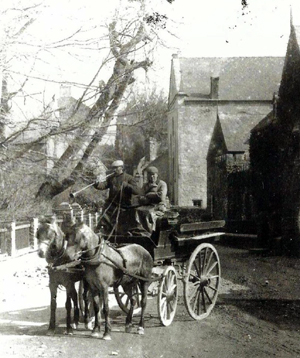
Major Congreve's son John, born in Island House in 1912, died in the Battle of Algeria in 1942 aged 31.
According to Steve John's remarkable research, 16 men with a Laugharne connection died in WW2 including Thomas Essery 'Tim' Rose-Richards
(third from the left below), born 1902.
Tim raced at Le Mans five times (coming 3rd in 1931-1933) and entered two Grand Prix, finishing 4th in Dieppe in 1934.
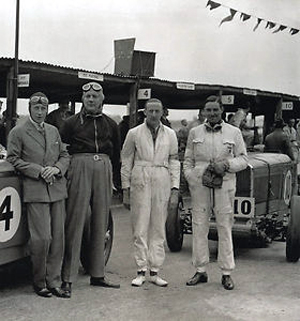
When war broke out Rose-Richards joined up for the Navy at the age of 37 and flew the incongruous Supermarine Walrus
which operated from HMS Daedalus. During the Battle of Britain on the 7th October 1940 a German bomber was forced into the waves.
Tim and his crew went to the rescue but were shot down. The bodies of the crew were never found.
Tim's father, Major Thomas Picton Rose-Richards, former MP for Mid-Breconshire, retired to Island House, hence the connection.
Tim clearly learned his racing ways from his father, for on the 19th September the Major was up in court for speeding near Llangunnor, Carmarthenshire.
He was on the wrong side of the road and did not sound his horn or give any signal of his approach. A witness said he was travelling at 'between fifteen and twenty miles an hour.'
The defendant claimed he was travelling at around eight to twelve miles an hour, but was found guilty and fined one pound.
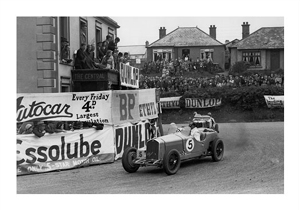
A gentleman called David 'Gosh' Waters lived here at the turn of the millennium. He was quite posh (hence 'Gosh') and wore cream suits.
Sadly, he was a heavy drinker and died in his 50s. The house was left to distant relatives who neglected the property.
The green garden door onto the Island House property was 'ajar' in 2014, and a professional photographer happened to be around for Dylan's centenary.
We went in and it was remarkable. Waters' possessions were still there, despite it being unlived in for a number of years and the house had
something of Dickens' Miss Havisham about it, but it's unlikely she had a Kermit the frog halfway up the stairs.
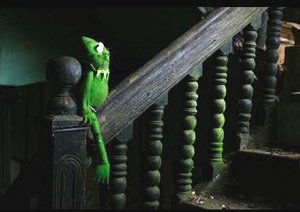

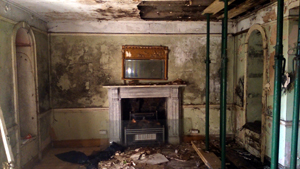
The house has deteriorated further since 2014, but happily Island House was bought in 2020 and a restoration is taking place. At present it seems that it will be a hotel and restaurant.
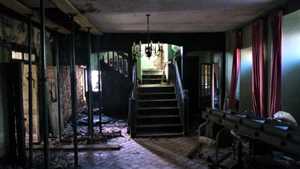
copyright © 2021 Laugharne Lines
all rights reserved